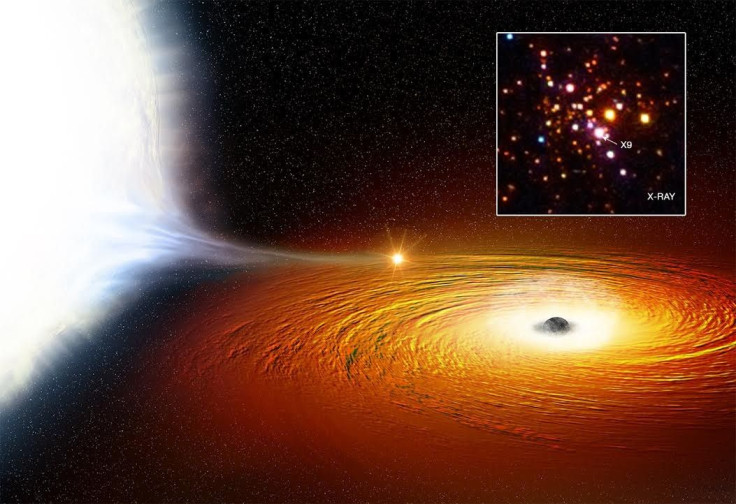Black Hole, White Dwarf Star In Closest Known Binary System With Smallest Orbit In Milky Way

A binary system in the globular cluster 47 Tucanae — about 14,800 light-years away from Earth but inside the Milky Way — has been known for years, but it was only in 2015 that astronomers found one of the stellar bodies was a black hole. And using new observations, scientists now think the other star is a white dwarf that orbits its companion at the closest distance to a black hole ever observed in our galaxy.
New observations of the binary system, called X9, were made using two NASA space telescopes — Chandra X-ray Observatory and NuSTAR — and the Australia Telescope Compact Array of the country’s Commonwealth Scientific and Industrial Research Organisation.
Read: A Supermassive Black Hole Ate A Dying Star For Over A Decade
Chandra revealed the likely orbital period of the white dwarf around the black hole is 28 minutes, the duration at which the telescope observed changes in X-ray brightness from the system. And the distance between the two objects is just about two and a half times that between Earth and the moon. The detailed findings have been accepted for publication in the Monthly Notices of the Royal Astronomical Society, under the title “The ultracompact nature of the black hole candidate X-ray binary 47 Tuc X9.”
Arash Bahramian, from the University of Alberta, Canada, and Michigan State University, and lead author of the study, said Monday in a statement: “This white dwarf is so close to the black hole that material is being pulled away from the star and dumped onto a disk of matter around the black hole before falling in. Luckily for this star, we don’t think it will follow this path into oblivion, but instead will stay in orbit.”
What, then, becomes of the white dwarf? Astronomers are not sure, but the theories are very interesting.
“We think the star may have been losing gas to the black hole for tens of millions of years and by now has now lost the majority of its mass. … Over time, we think that the star’s orbit will get wider and wider as even more mass is lost, eventually turning into an exotic object similar to the famous diamond planet discovered a few years ago,” James Miller-Jones, from Curtin University and the International Centre for Radio Astronomy Research (ICRAR), said in a statement Tuesday.
But how did such an incredibly close binary system involving a black hole form in the first place? One theory says the black hole smashed into a red giant, forcing gas from the outer regions of the star to escape the binary system, leaving behind the core which became a white dwarf orbiting the black hole. As the system emitted gravitational waves, its orbit shrunk till the black hole began pulling material from the star.
However, the gravitational waves from X9 have too low a frequency to be detected by present-day ground-based facilities.
Read: Sometimes, Black Holes Can Birth Stars
Another possible explanation for the existence of this strange stellar pair is that the white dwarf is actually orbiting a neutron star, not a black hole. In this hypothesis, the neutron star speeds up its own spin as it pulls material from the white dwarf, eventually having a rotational period of milliseconds. Such objects, called transitional millisecond pulsars, have been observed but some of their properties don’t match up with X9. Astronomers cannot disprove this theory but are not inclined to go with it.
Vlad Tudor, also from the Curtin University node of ICRAR, said in the statement: “Much like a spinning top as you pull the string from around its middle to make it go — but this theory doesn’t explain everything we’re seeing here, so our best current explanation is that we’re dealing with a white dwarf in extremely close proximity to a black hole.”
© Copyright IBTimes 2024. All rights reserved.




















